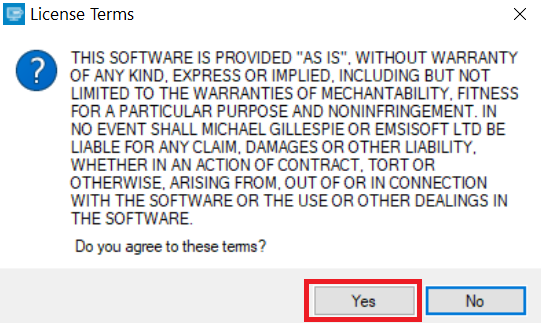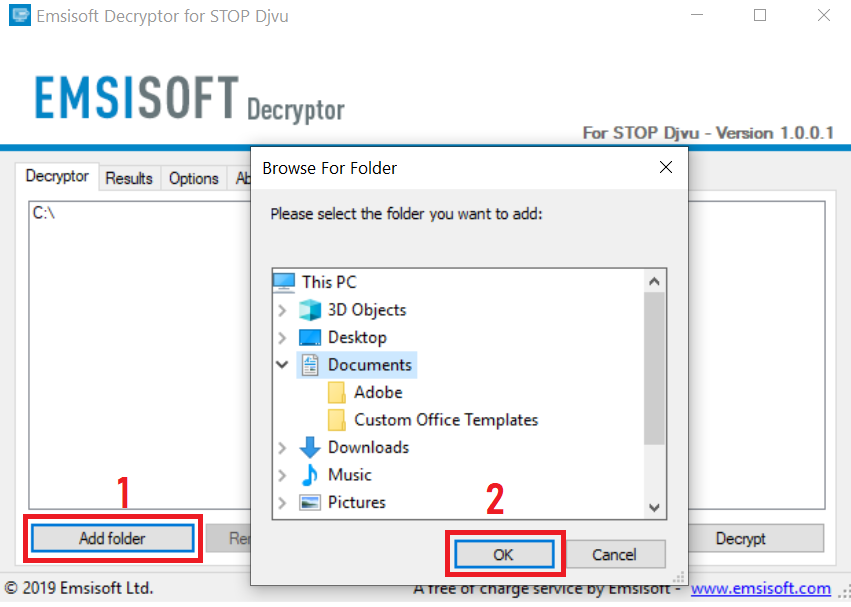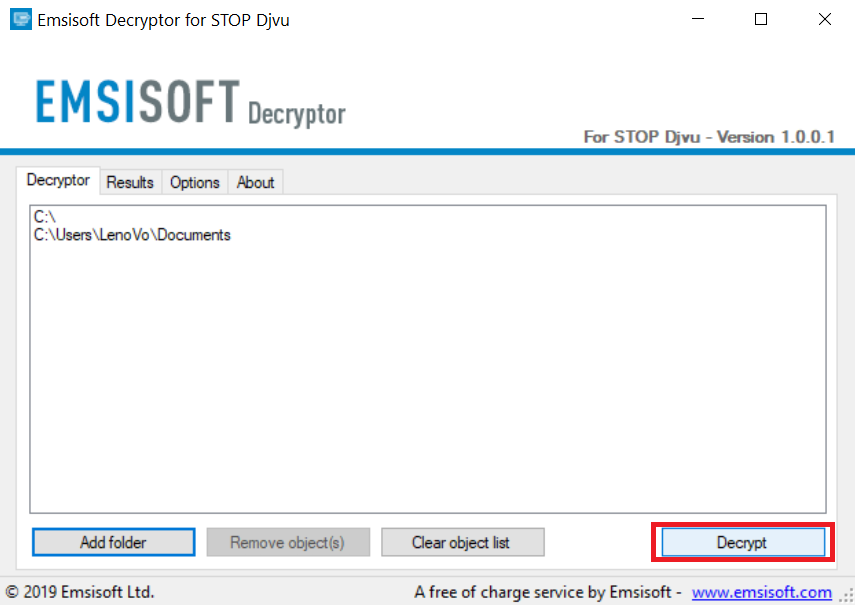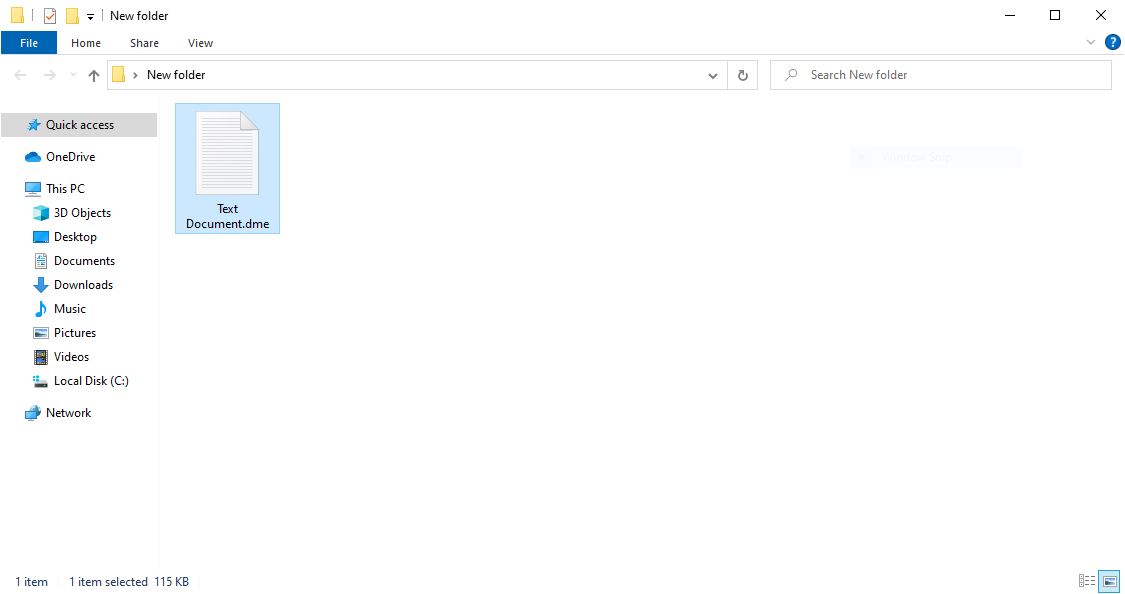Read this article to learn how to remove Dme ransomware and how to possibly recover files.
Dme Ransomware
Dme is the name of a Dharma ransomware virus that has been spotted in the wild. This cryptovirus is developed to corrupt computer operating systems and lock personal files. It lands on computer systems without being noticed. The encryption of personal files is followed by the creation of a ransom note called FILES ENCRYPTED.txt. This file aims to convince victims to contact hackers at one of the presented email addresses and ask for further details on ransom payment. Since .dme files remain inaccessible until their code is reverted back to the normal state, many users rush into paying the demanded ransom. However, even the successful completion of this step provides no guarantee that .dme files will be decrypted by the specialized decryption tool.
Read this article to learn how to get rid of malicious files installed by Dme ransomware and how to potentially restore files without paying the ransom.

.dme virus Summary
| Name | Dme |
| File Extension | .dme |
| Type | Ransomware, Cryptovirus |
| Ransom Notes | FILES ENCRYPTED.txt |
| What is It? | A ransomware that encodes your important files and asks you to pay a ransom to recover them. |
| Symptoms | All .dme files cannot be opened due to changes applied to their code. You are asked to contact hackers and pay a ransom for a data decryption tool. |
| Distribution Method | Spam Emails, Email Attachments, Executable Files, Hacked Websites |
| Removal | To effectively remove active .dme virus virus infections, we recommend that you use an advanced anti-malware tool. Download
Malware Removal Tool
|
User Experience | Join Our Forum to Discuss .dme virus. |
| Data Recovery Tool | Windows Data Recovery by Stellar Phoenix Notice! This product scans your drive sectors to recover lost files and it may not recover 100% of the encrypted files, but only few of them, depending on the situation and whether or not you have reformatted your drive. |
More Information About the Dme Ransomware Virus
The Dme ransomware virus is a file-encrypting malware that is specially designed by its creators to process sensitive user data found on the victim computers. They will be encrypted with a very strong algorithm and as a result, become inaccessible for the users. They will be then blackmailed to pay the hackers a given cryptocurrency fee to recover their files.
Dme ransomware virus can be distributed to the target victims using different tactics. As the identity of criminals is not known at this moment, we anticipate that popular strategies may be used:
- Payload Carriers — Malicious files can lead to the ransomware infection. The hackers can include the virus code in carriers such as documents of popular office formats: presentations, text documents, databases, and spreadsheets. The alternative is to create infected software installers. They are made by taking the original installers from their official sources and adding in the necessary virus code.
- Email Messages and Phishing Sites — All of the virus-related files and links to them can be directed to the computer targets via phishing strategies. They may be the sending of notifications and letters from fraud web services and companies or the hosting and advertising of hacker-controlled pages.
- Online Files Distribution — Via the use of stolen or specially created identities the relevant malware files may be distributed on different online communities where files are commonly shared between users. This includes not only the popular file-sharing networks, but also instant messaging applications, social networks, and online chats.
What we know is that the Dme ransomware virus can be spread using a lot of their techniques as well, as more and more samples are gathered more information will become available about the main strategies. According to the current research, the Dme ransomware virus is based on the Dharma family of threats. This shows that different hacking groups can create their own copies of this particular virus or use a customized version in their forthcoming hacking attacks.
From this, we can deduce that common actions related to such viruses will be run. One of the first components that are run in the beginning is the information harvesting procedure: it will hijack personal user’s information, system components, and other valuable data. This can be used for various crimes including identity and financial theft.
What follows are usually various types of system changes, including the following:
- Persistent Installation — The virus can be installed in a way that will automatically start it every time the computer is powered on. It can also disable access to the recovery boot options, this step will make it very hard to follow most manual user removal guides.
- Files Manipulation — Ransomware infections of this type may move, copy or remove files found on the hard drive. This may include backups and shadow volume copies.
- Windows Registry Editing — The main engine can edit existing values found in the computer’s Registry. This can lead to severe performance issues, the inability to start certain services and processes, as well as unexpected errors.
We remind our readers that at any time additional components may be added to the individual versions of this virus. When all relevant actions have completed execution the actual encryption phase will be run. This means that the engine will search for preset types of files that are to be processed. The complex algorithm will render the resulting data inaccessible and unusable. All of the converted files will be renamed with the .dme extension. To blackmail the victim users into paying the hackers a decryption fee, the virus automatically creates ransom notes and/or specific lockscreen instances displaying such instructions.

Remove Dme Virus – Try Restoring Files
In order to Remove Dme ransomware, we strongly recommend that you read the instructions in this article. Experts suggest that the best way towards fully erasing Dme Virus is to follow the removal steps that are underneath in combination with downloading an advanced malware removal tool. Such software will scan your computer for any malware and make sure that it’s fully gone from it.
- Step 1
- Step 2
- Step 3
- Step 4
- Step 5
Step 1: Scan for .dme virus with SpyHunter Anti-Malware Tool



Ransomware Automatic Removal - Video Guide
Step 2: Uninstall .dme virus and related malware from Windows
Here is a method in few easy steps that should be able to uninstall most programs. No matter if you are using Windows 10, 8, 7, Vista or XP, those steps will get the job done. Dragging the program or its folder to the recycle bin can be a very bad decision. If you do that, bits and pieces of the program are left behind, and that can lead to unstable work of your PC, errors with the file type associations and other unpleasant activities. The proper way to get a program off your computer is to Uninstall it. To do that:


 Follow the instructions above and you will successfully delete most unwanted and malicious programs.
Follow the instructions above and you will successfully delete most unwanted and malicious programs.
Step 3: Clean any registries, created by .dme virus on your computer.
The usually targeted registries of Windows machines are the following:
- HKEY_LOCAL_MACHINE\Software\Microsoft\Windows\CurrentVersion\Run
- HKEY_CURRENT_USER\Software\Microsoft\Windows\CurrentVersion\Run
- HKEY_LOCAL_MACHINE\Software\Microsoft\Windows\CurrentVersion\RunOnce
- HKEY_CURRENT_USER\Software\Microsoft\Windows\CurrentVersion\RunOnce
You can access them by opening the Windows registry editor and deleting any values, created by .dme virus there. This can happen by following the steps underneath:


 Tip: To find a virus-created value, you can right-click on it and click "Modify" to see which file it is set to run. If this is the virus file location, remove the value.
Tip: To find a virus-created value, you can right-click on it and click "Modify" to see which file it is set to run. If this is the virus file location, remove the value.
Before starting "Step 4", please boot back into Normal mode, in case you are currently in Safe Mode.
This will enable you to install and use SpyHunter 5 successfully.
Step 4: Boot Your PC In Safe Mode to isolate and remove .dme virus





Step 5: Try to Restore Files Encrypted by .dme virus.
Method 1: Use STOP Decrypter by Emsisoft.
Not all variants of this ransomware can be decrypted for free, but we have added the decryptor used by researchers that is often updated with the variants which become eventually decrypted. You can try and decrypt your files using the instructions below, but if they do not work, then unfortunately your variant of the ransomware virus is not decryptable.
Follow the instructions below to use the Emsisoft decrypter and decrypt your files for free. You can download the Emsisoft decryption tool linked here and then follow the steps provided below:
1 Right-click on the decrypter and click on Run as Administrator as shown below:

2. Agree with the license terms:

3. Click on "Add Folder" and then add the folders where you want files decrypted as shown underneath:

4. Click on "Decrypt" and wait for your files to be decoded.

Note: Credit for the decryptor goes to Emsisoft researchers who have made the breakthrough with this virus.
Method 2: Use data recovery software
Ransomware infections and .dme virus aim to encrypt your files using an encryption algorithm which may be very difficult to decrypt. This is why we have suggested a data recovery method that may help you go around direct decryption and try to restore your files. Bear in mind that this method may not be 100% effective but may also help you a little or a lot in different situations.
Simply click on the link and on the website menus on the top, choose Data Recovery - Data Recovery Wizard for Windows or Mac (depending on your OS), and then download and run the tool.
.dme virus-FAQ
What is .dme virus Ransomware?
.dme virus is a ransomware infection - the malicious software that enters your computer silently and blocks either access to the computer itself or encrypt your files.
Many ransomware viruses use sophisticated encryption algorithms to make your files inaccessible. The goal of ransomware infections is to demand that you pay a ransom payment to get access to your files back.
What Does .dme virus Ransomware Do?
Ransomware in general is a malicious software that is designed to block access to your computer or files until a ransom is paid.
Ransomware viruses can also damage your system, corrupt data and delete files, resulting in the permanent loss of important files.
How Does .dme virus Infect?
Via several ways..dme virus Ransomware infects computers by being sent via phishing emails, containing virus attachment. This attachment is usually masked as an important document, like an invoice, bank document or even a plane ticket and it looks very convincing to users.
Another way you may become a victim of .dme virus is if you download a fake installer, crack or patch from a low reputation website or if you click on a virus link. Many users report getting a ransomware infection by downloading torrents.
How to Open ..dme virus files?
You can't without a decryptor. At this point, the ..dme virus files are encrypted. You can only open them once they are decrypted using a specific decryption key for the particular algorithm.
What to Do If a Decryptor Does Not Work?
Do not panic, and backup the files. If a decryptor did not decrypt your ..dme virus files successfully, then do not despair, because this virus is still new.
Can I Restore "..dme virus" Files?
Yes, sometimes files can be restored. We have suggested several file recovery methods that could work if you want to restore ..dme virus files.
These methods are in no way 100% guaranteed that you will be able to get your files back. But if you have a backup, your chances of success are much greater.
How To Get Rid of .dme virus Virus?
The safest way and the most efficient one for the removal of this ransomware infection is the use a professional anti-malware program.
It will scan for and locate .dme virus ransomware and then remove it without causing any additional harm to your important ..dme virus files.
Can I Report Ransomware to Authorities?
In case your computer got infected with a ransomware infection, you can report it to the local Police departments. It can help authorities worldwide track and determine the perpetrators behind the virus that has infected your computer.
Below, we have prepared a list with government websites, where you can file a report in case you are a victim of a cybercrime:
Cyber-security authorities, responsible for handling ransomware attack reports in different regions all over the world:
Germany - Offizielles Portal der deutschen Polizei
United States - IC3 Internet Crime Complaint Centre
United Kingdom - Action Fraud Police
France - Ministère de l'Intérieur
Italy - Polizia Di Stato
Spain - Policía Nacional
Netherlands - Politie
Poland - Policja
Portugal - Polícia Judiciária
Greece - Cyber Crime Unit (Hellenic Police)
India - Mumbai Police - CyberCrime Investigation Cell
Australia - Australian High Tech Crime Center
Reports may be responded to in different timeframes, depending on your local authorities.
Can You Stop Ransomware from Encrypting Your Files?
Yes, you can prevent ransomware. The best way to do this is to ensure your computer system is updated with the latest security patches, use a reputable anti-malware program and firewall, backup your important files frequently, and avoid clicking on malicious links or downloading unknown files.
Can .dme virus Ransomware Steal Your Data?
Yes, in most cases ransomware will steal your information. It is a form of malware that steals data from a user's computer, encrypts it, and then demands a ransom in order to decrypt it.
In many cases, the malware authors or attackers will threaten to delete the data or publish it online unless the ransom is paid.
Can Ransomware Infect WiFi?
Yes, ransomware can infect WiFi networks, as malicious actors can use it to gain control of the network, steal confidential data, and lock out users. If a ransomware attack is successful, it could lead to a loss of service and/or data, and in some cases, financial losses.
Should I Pay Ransomware?
No, you should not pay ransomware extortionists. Paying them only encourages criminals and does not guarantee that the files or data will be restored. The better approach is to have a secure backup of important data and be vigilant about security in the first place.
What Happens If I Don't Pay Ransom?
If you don't pay the ransom, the hackers may still have access to your computer, data, or files and may continue to threaten to expose or delete them, or even use them to commit cybercrimes. In some cases, they may even continue to demand additional ransom payments.
Can a Ransomware Attack Be Detected?
Yes, ransomware can be detected. Anti-malware software and other advanced security tools can detect ransomware and alert the user when it is present on a machine.
It is important to stay up-to-date on the latest security measures and to keep security software updated to ensure ransomware can be detected and prevented.
Do Ransomware Criminals Get Caught?
Yes, ransomware criminals do get caught. Law enforcement agencies, such as the FBI, Interpol and others have been successful in tracking down and prosecuting ransomware criminals in the US and other countries. As ransomware threats continue to increase, so does the enforcement activity.
About the .dme virus Research
The content we publish on SensorsTechForum.com, this .dme virus how-to removal guide included, is the outcome of extensive research, hard work and our team’s devotion to help you remove the specific malware and restore your encrypted files.
How did we conduct the research on this ransomware?
Our research is based on an independent investigation. We are in contact with independent security researchers, and as such, we receive daily updates on the latest malware and ransomware definitions.
Furthermore, the research behind the .dme virus ransomware threat is backed with VirusTotal and the NoMoreRansom project.
To better understand the ransomware threat, please refer to the following articles which provide knowledgeable details.
As a site that has been dedicated to providing free removal instructions for ransomware and malware since 2014, SensorsTechForum’s recommendation is to only pay attention to trustworthy sources.
How to recognize trustworthy sources:
- Always check "About Us" web page.
- Profile of the content creator.
- Make sure that real people are behind the site and not fake names and profiles.
- Verify Facebook, LinkedIn and Twitter personal profiles.














